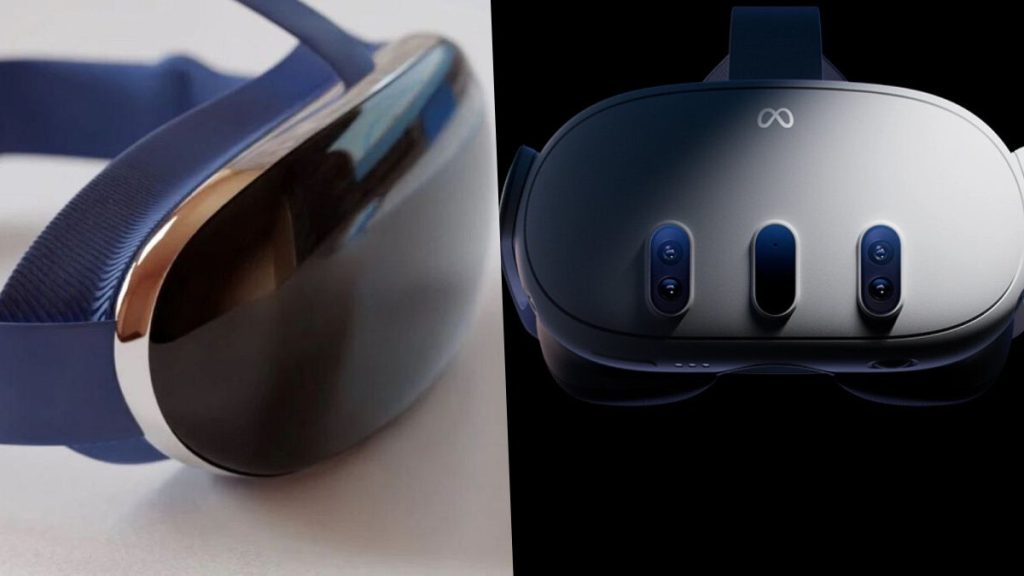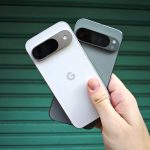Meta Quest 3 vs Apple Vision Pro : The mixed reality (MR) revolution is in full swing in 2025, with two tech titans leading the charge. As spatial computing becomes more integrated into everyday life—from gaming and productivity to virtual collaboration and immersive content consumption—choosing the right headset is more critical than ever.
So, which one is better for your needs in 2025? Let’s break it down by comparing their hardware capabilities, ecosystems, AR/VR/MR performance, app support, and pricing.
1. Design and Comfort: Sleek vs Functional
- Apple Vision Pro: Apple continues its tradition of elegant design with the Vision Pro. It’s made from aluminum and glass, with a customizable headband and optical inserts for glasses wearers. The eye-tracking and hand gesture system is seamless, but the headset is relatively heavier, which can affect extended use.
- Meta Quest 3: Meta’s headset is lighter and more compact than its predecessor, making it ideal for longer gaming or fitness sessions. It features pancake lenses for improved optics and comfort and uses touch controllers alongside hand tracking.
Verdict: Apple wins on premium design, but Meta wins on comfort and ergonomics for active use.

2. Display & Optics: Immersion That Matters
- Apple Vision Pro boasts dual micro-OLED 4K displays, delivering ultra-crisp visuals with deep blacks and high brightness. The passthrough AR experience is nearly photorealistic, allowing real-world and digital content to blend almost seamlessly.
- Meta Quest 3 has improved resolution over the Quest 2 but doesn’t quite match Apple’s visual fidelity. However, it features full-color passthrough, depth sensing, and 120Hz refresh rate, making it great for gaming and casual MR experiences.
Verdict: Apple dominates on display quality, but Meta offers strong visuals at a fraction of the price.
3. AR, VR, and MR Capabilities: Immersive Ecosystems
- Apple Vision Pro is a true MR headset, running visionOS, which supports floating app windows, spatial browsing, cinematic environments, and AR overlays. It blurs the lines between physical and digital worlds, ideal for productivity, creativity, and media consumption.
- Meta Quest 3 leans heavily into VR and MR gaming, with AR features baked into the experience. Thanks to Meta Reality, users can place 3D objects in the real world, interact with digital overlays, and run MR games that respond to physical surroundings.
Verdict: Apple wins for work and content consumption; Meta wins for immersive entertainment and fitness.
4. App Ecosystem & Developer Support
- Apple Vision Pro has access to the App Store, including MR-optimized apps and many existing iPad/iOS apps. Developers are slowly adapting to visionOS, but 2025 has brought a growing list of third-party productivity, design, and media apps.
- Meta Quest 3 continues to dominate in VR gaming, thanks to Meta’s vast content library and Oculus Store, including exclusives like Beat Saber, Asgard’s Wrath 2, and Population: One. Meta is also investing in MR tools like Horizon Workrooms and immersive social spaces.
Verdict: Apple has a versatile app ecosystem; Meta offers a superior gaming library and social VR experience.

5. Performance & Hardware
- Apple Vision Pro uses the M2 chip paired with an R1 chip for real-time sensor input, ensuring ultra-low latency and fluid interactions. The device is powerful enough to run multiple apps in spatial mode without a hitch.
- Meta Quest 3 runs on the Qualcomm Snapdragon XR2 Gen 2, delivering notable performance gains over Quest 2. It supports advanced graphics and spatial audio but doesn’t match Apple’s desktop-class power.
Verdict: Apple offers smoother multitasking; Meta provides great performance for a standalone device.
6. Pricing: Premium vs Practical
- Apple Vision Pro is a premium device with a premium price tag — starting at $3,499. While it’s positioned as a spatial computer, it’s out of reach for most casual users.
- Meta Quest 3 starts at $499, making it one of the most accessible mixed reality headsets in 2025. Meta also offers bundle deals, making it attractive for gamers, students, and developers.
Verdict: Meta wins hands-down on affordability.
Final Verdict: Which One Should You Buy?
- Choose Apple Vision Pro if you’re an Apple ecosystem user looking for cutting-edge productivity, design, or media experiences with the most refined MR hardware available.
- Choose Meta Quest 3 if you’re focused on gaming, fitness, virtual collaboration, or want an affordable gateway into immersive tech.
In 2025, both headsets represent different visions of the future of mixed reality — Apple is redefining spatial computing, while Meta is democratizing immersive experiences.
🚀 Stay Ahead in AR/VR Tech
For more in-depth comparisons, news, and tech reviews, follow TechnicalTalkz.com — your destination for all things immersive and intelligent in 2025.



